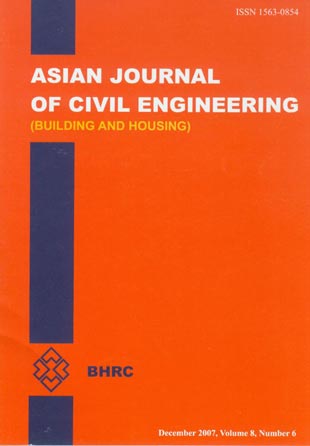فهرست مطالب

Asian journal of civil engineering
Volume:8 Issue: 6, December 2007
- 110 صفحه،
- تاریخ انتشار: 1387/02/01
- تعداد عناوین: 7
-
-
Page 581In the recent years, attempts have been made to upgrade existing RC Ordinary MomentResisting Frames (OMRF) into Ductile Moment Resisting Frame (DMRF). In practice, thiscan be implemented by controlling the plastic hinges locations. This paper presents theresults of an experimental study performed to evaluate the ability of CFRP sheets inpreventing the plastic hinge formation at the face of the column in exterior RC joints. Fiveplain/CFRP-retrofitted scaled-down joints of a typical OMRF were tested undermonotonic/cyclic loads to failure. The results show that carbon fibre can effectively relocate the plastic hinge away from the column face.
-
Page 597Flowing concretes were produced using quarry waste as a partial replacement of naturalmining sand. The non-destructive properties such as dynamic modulus of elasticity,ultrasonic pulse velocity, and initial surface absorption were investigated. The slump, slumpflow, V-funnel flow, air content and compressive strength of the concretes were alsodetermined. The variations of dynamic modulus of elasticity, ultrasonic pulse velocity, andinitial surface absorption with compressive strength were observed. In addition, therelationship of the aforementioned non-destructive properties was examined. Test resultsindicate that quarry waste did not significantly affect the non-destructive properties of theconcretes except initial surface absorption. Dynamic modulus of elasticity, ultrasonic pulsevelocity, and initial surface absorption varied linearly with compressive strength. Moreover,dynamic modulus of elasticity and ultrasonic pulse velocity were well-correlated.
-
Page 615In any design of steel structures to resist fire, it is essential to know the temperature of the steel. A simple step-by-step calculation technique is illustrated to determine the temperature of non-insulated and insulated AISC rolled steel sections exposed to a standard fire. The time-temperature responses of the insulated rolled steel sections has been determined for varying thicknesses of two insulating materials viz. concrete and cement plaster. The rolled steel section has been idealized as a lumped mass of steel having a uniform temperature. The ISO 834 specified time-temperature curve has been used as an input in the analysis. The proposed procedure is a useful tool for predicting temperatures of non-insulated and insulated simple rolled steel sections in standard fire-resistance tests and also helps to illustrate the efficacy of the type and the thickness of the insulating material on the elevation of temperature in the steel sections. The results of this investigation can be used to determine the fire-resistance ratings in the temperature domain for simple steel members.
-
Page 629Damage indexes consider different aspects of structural response with the objective ofproducing a quantitative measure of structural damage. In this paper, damage indexes based on deformation, energy, modal parameters and low cycle fatigue behavior are investigated in order to find a correlation between their numerical values. Selected damage indexes are compared by applying them in the nonlinear analysis of various low rise steel frames subjected to a set of seven earthquake accelerograms corresponding to a specific soil condition. Correlations between various indexes have been presented graphically and approximate conversion formulas are also provided.
-
Page 647In the present study, free vibration, deflection and buckling analyses of rectangularcomposite plates via discrete singular convolution has been presented. In the proposedapproach, the derivatives in both the governing equations and the boundary conditions are discretized by the method of DSC. The obtained results are compared with those of other numerical methods available in the literature. Numerical calculations showed that accurate results can be achieved. It has been also shown that the DSC method yields efficient and convergence solutions and these results are in excellent agreement with the analytical solutions and other sources of numerical solutions.
-
Page 659In recent years special methods have been presented for eigensolution of symmetricstructures. Therefore, an automatic approach for detecting the symmetry axis and/or planes was inevitable. In this paper a simple automatic approach is developed for symmetrydetection in structural graph models. This is achieved by a special coloring of graph utilizingthe dominant eigenvector of a special matrix known as the inner-product matrix, andimposing some constraints. Combining the present method and some canonical forms, anefficient tool is obtained for graph factorization. The efficiency of the present method isillustrated through some examples.
-
Page 677The transformation from a conventional consumption based society to a sustainable society is urgently required due to the pollution of the natural environment, the exhaustion of the natural resources and the decreasing capacity of the final waste disposal facilities. One of the ways to solve this problem is to use Building Demolished Waste (BDW) concrete as aggregates in structural concrete. The aggregates thus obtained can be called as Recycled Concrete Aggregate (RCA).Concrete is a versatile material with numerous applications, but the only problem with concrete is its brittle behaviour more so in recycled aggregate concrete. This brittleness in concrete can be overcome by dispersing fibers discretely in the material of concrete. In the present work, Glass Fiber Reinforced Recycled Aggregate Concrete (GFRRAC) was developed. The mechanical properties of GFRAC with M20 & M40 grade concretes, for different replacements of Recycled Concrete Aggregate (RCA) in Natural Aggregate (NA) are presented. It was observed that there was 10-17 % increase in split tensile strength and about 10-14 % improvement in flexural strength with fiber addition in recycled aggregate concrete. There is an improvement in the modulus of elasticity of concrete. The values of split, flexure and modulus of elasticity obtained were also compared with the Indian Standard Codal Provisions. The increased energy absorption capacity in GFRRAC indicates higher toughness and better post elastic deformations in the event of seismic actions.


